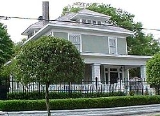
Springfield, Jacksonville, Florida
Encyclopedia
Springfield is a historic neighborhood of Jacksonville
, Florida
, located to the north of downtown. Established in 1869, it experienced its greatest growth from the early 1880s through the 1920s. The Springfield Historic District is listed in the National Register of Historic Places
, and contains some of the city's best examples of 19th and early 20th century architecture
.
In 1901, most of downtown Jacksonville was burned down in the Great Fire of 1901
. The flames and smoke from the Great Fire was so heavy, the smoke was reportedly seen as far away as North Carolina
. The fire lasted 8 hours and consumed 146 city blocks, 3268 buildings, and killed seven people. After the fire, many of the city's most prominent and wealthy citizens were now homeless, and turned to Springfield for help. Springfield became a wealthy suburb
because several wealthy residents built their homes there.
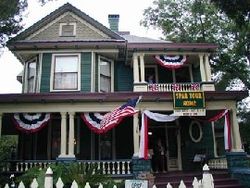 The Springfield Historic District, located just north of downtown Jacksonville, is composed mainly of wood frame residential buildings and a much smaller number of masonry commercial, religious, educational, and civic structures. Its concentrated physical development began about 1882 with the formation of the Springfield Development Company and accelerated after the fire that destroyed much of downtown Jacksonville in 1901. Contributing buildings in the district date from about 1885 to approximately 1930. The majority of the houses are wood frame vernacular structures
The Springfield Historic District, located just north of downtown Jacksonville, is composed mainly of wood frame residential buildings and a much smaller number of masonry commercial, religious, educational, and civic structures. Its concentrated physical development began about 1882 with the formation of the Springfield Development Company and accelerated after the fire that destroyed much of downtown Jacksonville in 1901. Contributing buildings in the district date from about 1885 to approximately 1930. The majority of the houses are wood frame vernacular structures
, but there are some examples of late 19th century revival and romantic styles, including Queen Anne
, Colonial Revival, and the Stick style. 20th century types include Prairie School
, Bungalow
, and Mediterranean
.
The boundaries of Springfield are well defined. Hogan's Creek lies along its south edge, and railroad lines are found on the north and east. Boulevard defines the western limit of the district where a later commercial strip abuts the earlier residential area. Contemporary with the overall residential area are two commercial strips along Main and Eighth Streets which join at the heart of the district. The district contains 119 city blocks in an area of approximately 500 acres (2 km²), or slightly less than one square mile. Hogan's Creek separates the residences of Springfield from the downtown business district. North of the creek few buildings rise above two stories and parks and tree lined streets are common.
The blocks of the historic district are laid out in a regular grid, with named streets running north and south and numbered streets east and west. Most of the blocks have alleys, usually arranged in an "H" pattern, although other configurations are found. A few streets retain their original brick pavers and granite curbstones, but the majority are now covered with asphalt and have concrete curbs. Sidewalks feature both the earlier hexagonal pavers and modern poured concrete sections. Trees lend considerable distinction to the neighborhood. Oaks predominate. Scattered throughout the neighborhood are such decorative elements as hitching posts, cast iron fences, rusticated concrete block walls and carriage stepping stones, testimony to the area's turn-of-the-century origins. There is, however, no great concentration of such elements.
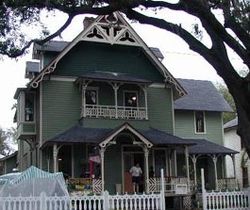 Some additional commercial and industrial buildings are found along the northern and eastern boundaries of the district in conjunction with the railroad lines, and isolated commercial structures are found within the neighborhood. Schools, churches, multi-family residences and parks are found throughout the neighborhood. Although there are a number of modern intrusions along Springfield's main commercial arteries, these have not proved so numerous as to be overwhelming. Also, except for demolitions, the residential area remains largely unchanged, with relatively little post-1930 construction.
Some additional commercial and industrial buildings are found along the northern and eastern boundaries of the district in conjunction with the railroad lines, and isolated commercial structures are found within the neighborhood. Schools, churches, multi-family residences and parks are found throughout the neighborhood. Although there are a number of modern intrusions along Springfield's main commercial arteries, these have not proved so numerous as to be overwhelming. Also, except for demolitions, the residential area remains largely unchanged, with relatively little post-1930 construction.
At the time the district was listed in the National Register, it contained 1,784 buildings fifty years old or older that contributed to its historical character. Of that number, 1,686 were classified as residential. Only 48 were commercial. The great majority of buildings, 1,595, were wood frame, and 201 were masonry. There were 1,294 buildings of two stories in height and 10 three-story structures. The remainder were all one-story structures.
Contributing buildings were all fifty years old or older and retained enough of their original physical character to adequately embody the sense of time, place, and historic association normally required in establishing a historic district. These comprised 95 percent of all of the buildings in the district. The non-contributing buildings were either less than fifty years old and lacked exceptional significance or were more than fifty years old but retained little, if any, of their original physical integrity. These numbered five percent of the total.
The neighborhood did not experience a resurgence of construction during the 1920s, as did other residential sections of the city, and the "boom" bypassed the area since much of the land was already occupied, except in the area north of Eighth Street. Construction was, therefore, limited to the occasional vacant lot or those sites where older structures had been lost or required replacement.
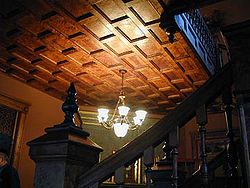 There were 1,038 frame vernacular buildings in the historic district that possessed no discernible stylistic features, though in certain cases the decorative details may have been removed in later remodeling. Most of these vernacular buildings are two stories in height with a gable
There were 1,038 frame vernacular buildings in the historic district that possessed no discernible stylistic features, though in certain cases the decorative details may have been removed in later remodeling. Most of these vernacular buildings are two stories in height with a gable
or hip roof
. The wood frame buildings that retain their original fabric are generally clad with weatherboard or novelty siding or, in a few cases, wood shingles. In many cases, aluminum, vinyl, or asbestos siding have been applied to the exterior of houses. One-story porches and verandas are common, and there are some porches with upper galleries. There are a variety of sash and casement window
types. Masonry vernacular buildings are generally brick or stuccoed and are either one or two stories in height. Most of these are commercial buildings with fixed glass storefronts. Few exhibit any ornamentation. Their roofs are usually the flat built-up variety with parapets on the street facade.
Although the majority of buildings in Springfield are vernacular, many others embody styles or architectural influences contemporary with the development of the district. The influence of the Colonial Revival, Queen Anne, and Prairie styles is particularly evident. Other minor styles are represented as well.
Henry John Klutho
was Jacksonville's most influential architect during the first years of the twentieth century and its leading proponent of the Prairie School. The house he designed as his own residence in Springfield was said to be the first in Florida to draw on the "modernist" architectural movements in America.
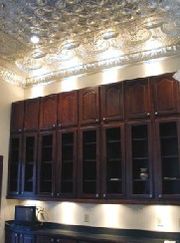 Beyond its architecture, the Springfield Historic District has other attractive physical features. The most prominent of these are the historic parks and structures which define the southern boundary of the neighborhood along Hogan's Creek. Recreational facilities and parks constitute 30.91 acres (125,088.4 m²) of Springfield or approximately five percent of the total land area. The parks along Hogan's Creek account for most of this area. Klutho (Springfield) Park comprises 17.47 acres (70,698.6 m²) and Confederate Park another 8.3 acres (33,588.9 m²). Along the creek itself are the balustrades and bridges designed by Klutho in 1929. Other greenspaces in the district are small neighborhood parks and playgrounds.
Beyond its architecture, the Springfield Historic District has other attractive physical features. The most prominent of these are the historic parks and structures which define the southern boundary of the neighborhood along Hogan's Creek. Recreational facilities and parks constitute 30.91 acres (125,088.4 m²) of Springfield or approximately five percent of the total land area. The parks along Hogan's Creek account for most of this area. Klutho (Springfield) Park comprises 17.47 acres (70,698.6 m²) and Confederate Park another 8.3 acres (33,588.9 m²). Along the creek itself are the balustrades and bridges designed by Klutho in 1929. Other greenspaces in the district are small neighborhood parks and playgrounds.
The neighborhood's rapid redevelopment has been led by a partnership of municipal programs, private real estate developers, progressive not-for-profit corporations and arts and cultural developers. Springfield is now home to nearly all the independent theatre and film productions in the city.
The January 2010 issue of Southern Living
magazine spotlights Springfield as they #1 "comeback" neighborhood in the South, noting significant improvement over the past decade.
The December 2010 issue of Florida Trend Magazine also featured the Springfield Historic District in an article titled "A Life of Its Own". The piece detailed how, despite the down housing market, the neighborhood has continued to thrive.
Jacksonville, Florida
Jacksonville is the largest city in the U.S. state of Florida in terms of both population and land area, and the largest city by area in the contiguous United States. It is the county seat of Duval County, with which the city government consolidated in 1968...
, Florida
Florida
Florida is a state in the southeastern United States, located on the nation's Atlantic and Gulf coasts. It is bordered to the west by the Gulf of Mexico, to the north by Alabama and Georgia and to the east by the Atlantic Ocean. With a population of 18,801,310 as measured by the 2010 census, it...
, located to the north of downtown. Established in 1869, it experienced its greatest growth from the early 1880s through the 1920s. The Springfield Historic District is listed in the National Register of Historic Places
National Register of Historic Places
The National Register of Historic Places is the United States government's official list of districts, sites, buildings, structures, and objects deemed worthy of preservation...
, and contains some of the city's best examples of 19th and early 20th century architecture
Architecture
Architecture is both the process and product of planning, designing and construction. Architectural works, in the material form of buildings, are often perceived as cultural and political symbols and as works of art...
.
In 1901, most of downtown Jacksonville was burned down in the Great Fire of 1901
Great Fire of 1901
The Great Fire of 1901 in Jacksonville, Florida was one of the worst disasters in Florida history and the largest urban fire in the Southeast. It was similar in scale and destruction to the 1871 Great Chicago Fire.-Origin:...
. The flames and smoke from the Great Fire was so heavy, the smoke was reportedly seen as far away as North Carolina
North Carolina
North Carolina is a state located in the southeastern United States. The state borders South Carolina and Georgia to the south, Tennessee to the west and Virginia to the north. North Carolina contains 100 counties. Its capital is Raleigh, and its largest city is Charlotte...
. The fire lasted 8 hours and consumed 146 city blocks, 3268 buildings, and killed seven people. After the fire, many of the city's most prominent and wealthy citizens were now homeless, and turned to Springfield for help. Springfield became a wealthy suburb
Suburb
The word suburb mostly refers to a residential area, either existing as part of a city or as a separate residential community within commuting distance of a city . Some suburbs have a degree of administrative autonomy, and most have lower population density than inner city neighborhoods...
because several wealthy residents built their homes there.
The Springfield Historic District

Vernacular architecture
Vernacular architecture is a term used to categorize methods of construction which use locally available resources and traditions to address local needs and circumstances. Vernacular architecture tends to evolve over time to reflect the environmental, cultural and historical context in which it...
, but there are some examples of late 19th century revival and romantic styles, including Queen Anne
Queen Anne Style architecture
The Queen Anne Style in Britain means either the English Baroque architectural style roughly of the reign of Queen Anne , or a revived form that was popular in the last quarter of the 19th century and the early decades of the 20th century...
, Colonial Revival, and the Stick style. 20th century types include Prairie School
Prairie School
Prairie School was a late 19th and early 20th century architectural style, most common to the Midwestern United States.The works of the Prairie School architects are usually marked by horizontal lines, flat or hipped roofs with broad overhanging eaves, windows grouped in horizontal bands,...
, Bungalow
Bungalow
A bungalow is a type of house, with varying meanings across the world. Common features to many of these definitions include being detached, low-rise , and the use of verandahs...
, and Mediterranean
Mediterranean Revival Style architecture
The Mediterranean Revival was an eclectic design style that was first introduced in the United States about the end of the nineteenth century, and became popular during the 1920s and 1930s...
.
The boundaries of Springfield are well defined. Hogan's Creek lies along its south edge, and railroad lines are found on the north and east. Boulevard defines the western limit of the district where a later commercial strip abuts the earlier residential area. Contemporary with the overall residential area are two commercial strips along Main and Eighth Streets which join at the heart of the district. The district contains 119 city blocks in an area of approximately 500 acres (2 km²), or slightly less than one square mile. Hogan's Creek separates the residences of Springfield from the downtown business district. North of the creek few buildings rise above two stories and parks and tree lined streets are common.
The blocks of the historic district are laid out in a regular grid, with named streets running north and south and numbered streets east and west. Most of the blocks have alleys, usually arranged in an "H" pattern, although other configurations are found. A few streets retain their original brick pavers and granite curbstones, but the majority are now covered with asphalt and have concrete curbs. Sidewalks feature both the earlier hexagonal pavers and modern poured concrete sections. Trees lend considerable distinction to the neighborhood. Oaks predominate. Scattered throughout the neighborhood are such decorative elements as hitching posts, cast iron fences, rusticated concrete block walls and carriage stepping stones, testimony to the area's turn-of-the-century origins. There is, however, no great concentration of such elements.
Architecture

At the time the district was listed in the National Register, it contained 1,784 buildings fifty years old or older that contributed to its historical character. Of that number, 1,686 were classified as residential. Only 48 were commercial. The great majority of buildings, 1,595, were wood frame, and 201 were masonry. There were 1,294 buildings of two stories in height and 10 three-story structures. The remainder were all one-story structures.
Contributing buildings were all fifty years old or older and retained enough of their original physical character to adequately embody the sense of time, place, and historic association normally required in establishing a historic district. These comprised 95 percent of all of the buildings in the district. The non-contributing buildings were either less than fifty years old and lacked exceptional significance or were more than fifty years old but retained little, if any, of their original physical integrity. These numbered five percent of the total.
The neighborhood did not experience a resurgence of construction during the 1920s, as did other residential sections of the city, and the "boom" bypassed the area since much of the land was already occupied, except in the area north of Eighth Street. Construction was, therefore, limited to the occasional vacant lot or those sites where older structures had been lost or required replacement.

Gable
A gable is the generally triangular portion of a wall between the edges of a sloping roof. The shape of the gable and how it is detailed depends on the structural system being used and aesthetic concerns. Thus the type of roof enclosing the volume dictates the shape of the gable...
or hip roof
Hip roof
A hip roof, or hipped roof, is a type of roof where all sides slope downwards to the walls, usually with a fairly gentle slope. Thus it is a house with no gables or other vertical sides to the roof. A square hip roof is shaped like a pyramid. Hip roofs on the houses could have two triangular side...
. The wood frame buildings that retain their original fabric are generally clad with weatherboard or novelty siding or, in a few cases, wood shingles. In many cases, aluminum, vinyl, or asbestos siding have been applied to the exterior of houses. One-story porches and verandas are common, and there are some porches with upper galleries. There are a variety of sash and casement window
Casement window
A casement window is a window that is attached to its frame by one or more hinges. Casement windows are hinged at the side. A casement window (or casement) is a window that is attached to its frame by one or more hinges. Casement windows are hinged at the side. A casement window (or casement) is a...
types. Masonry vernacular buildings are generally brick or stuccoed and are either one or two stories in height. Most of these are commercial buildings with fixed glass storefronts. Few exhibit any ornamentation. Their roofs are usually the flat built-up variety with parapets on the street facade.
Although the majority of buildings in Springfield are vernacular, many others embody styles or architectural influences contemporary with the development of the district. The influence of the Colonial Revival, Queen Anne, and Prairie styles is particularly evident. Other minor styles are represented as well.
Henry John Klutho
Henry John Klutho
Henry John Klutho was an American architect of the "Prairie School" style. He helped in the reconstruction of Jacksonville, Florida after the Great Fire of 1901—the largest-ever urban fire in the Southeast—by designing many of the new buildings built after the disaster. This period lasted until...
was Jacksonville's most influential architect during the first years of the twentieth century and its leading proponent of the Prairie School. The house he designed as his own residence in Springfield was said to be the first in Florida to draw on the "modernist" architectural movements in America.
Springfield today

The neighborhood's rapid redevelopment has been led by a partnership of municipal programs, private real estate developers, progressive not-for-profit corporations and arts and cultural developers. Springfield is now home to nearly all the independent theatre and film productions in the city.
- This historical overview of Springfield is adapted from Jacksonville's Architectural Heritage: Landmarks for the Future, Wayne W. Wood, 1989, Jacksonville, Florida.
The January 2010 issue of Southern Living
Southern Living
Southern Living is a widely read lifestyle magazine aimed at readers in the Southern United States featuring recipes, house plans, and information about Southern culture and travel...
magazine spotlights Springfield as they #1 "comeback" neighborhood in the South, noting significant improvement over the past decade.
The December 2010 issue of Florida Trend Magazine also featured the Springfield Historic District in an article titled "A Life of Its Own". The piece detailed how, despite the down housing market, the neighborhood has continued to thrive.
External links
- Springfield Preservation and Revitalization Council
- Springfield Area Merchants and Business Association
- mySpringfield
- Fresh Ministries
- Operation New Hope
- SRG Homes & Neighborhoods
- UrbanJacksonville
- Historic Springfield Neighborhood Watch
- Springfield Animal Care and Rescue Club
- Springfield Improvement Association and Womans Club
- Sustainable Springfield

